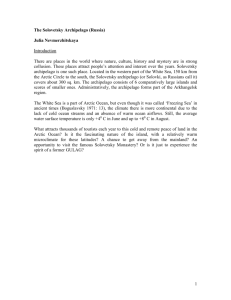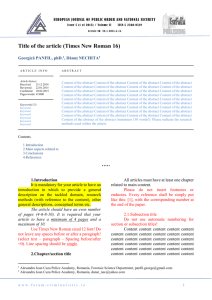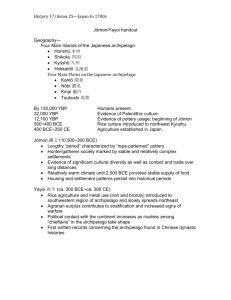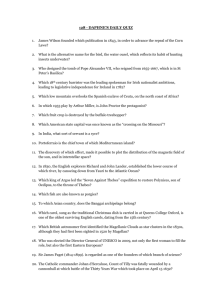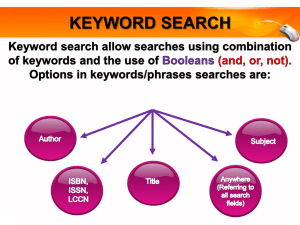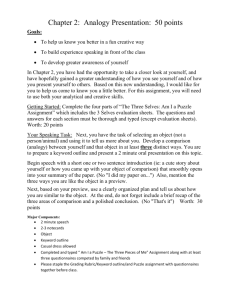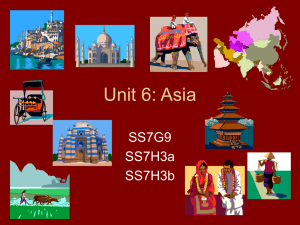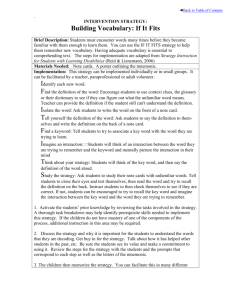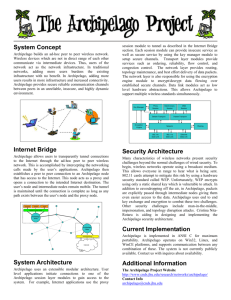Vocabulary Instruction
advertisement
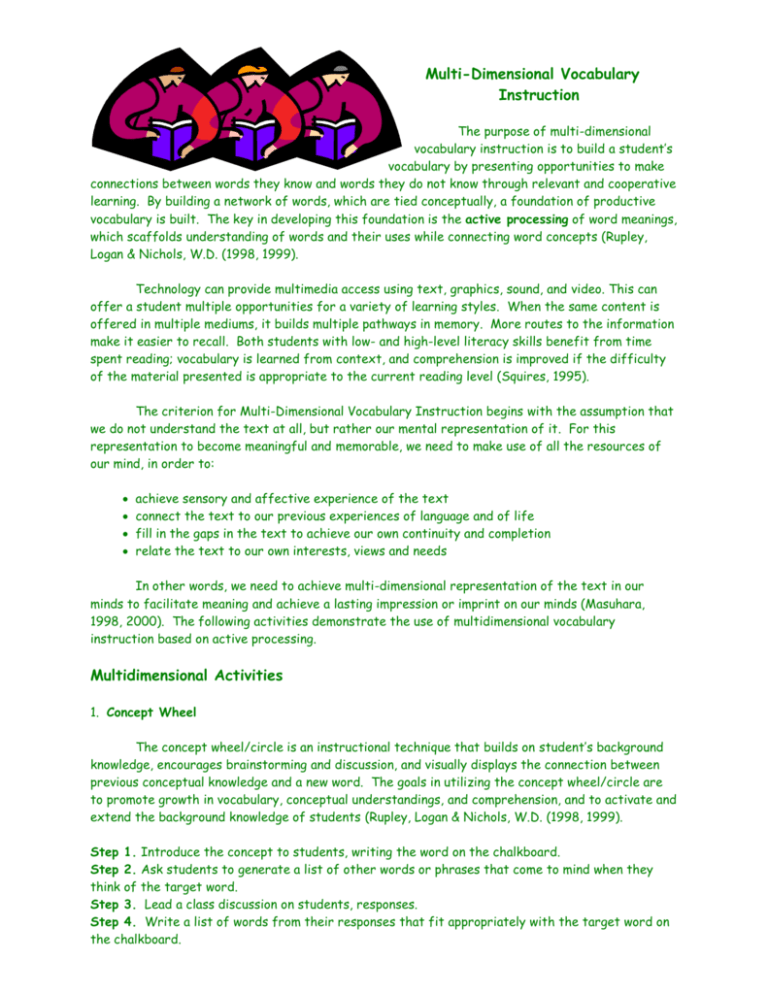
Multi-Dimensional Vocabulary Instruction The purpose of multi-dimensional vocabulary instruction is to build a student’s vocabulary by presenting opportunities to make connections between words they know and words they do not know through relevant and cooperative learning. By building a network of words, which are tied conceptually, a foundation of productive vocabulary is built. The key in developing this foundation is the active processing of word meanings, which scaffolds understanding of words and their uses while connecting word concepts (Rupley, Logan & Nichols, W.D. (1998, 1999). Technology can provide multimedia access using text, graphics, sound, and video. This can offer a student multiple opportunities for a variety of learning styles. When the same content is offered in multiple mediums, it builds multiple pathways in memory. More routes to the information make it easier to recall. Both students with low- and high-level literacy skills benefit from time spent reading; vocabulary is learned from context, and comprehension is improved if the difficulty of the material presented is appropriate to the current reading level (Squires, 1995). The criterion for Multi-Dimensional Vocabulary Instruction begins with the assumption that we do not understand the text at all, but rather our mental representation of it. For this representation to become meaningful and memorable, we need to make use of all the resources of our mind, in order to: achieve sensory and affective experience of the text connect the text to our previous experiences of language and of life fill in the gaps in the text to achieve our own continuity and completion relate the text to our own interests, views and needs In other words, we need to achieve multi-dimensional representation of the text in our minds to facilitate meaning and achieve a lasting impression or imprint on our minds (Masuhara, 1998, 2000). The following activities demonstrate the use of multidimensional vocabulary instruction based on active processing. Multidimensional Activities 1. Concept Wheel The concept wheel/circle is an instructional technique that builds on student’s background knowledge, encourages brainstorming and discussion, and visually displays the connection between previous conceptual knowledge and a new word. The goals in utilizing the concept wheel/circle are to promote growth in vocabulary, conceptual understandings, and comprehension, and to activate and extend the background knowledge of students (Rupley, Logan & Nichols, W.D. (1998, 1999). Step 1. Introduce the concept to students, writing the word on the chalkboard. Step 2. Ask students to generate a list of other words or phrases that come to mind when they think of the target word. Step 3. Lead a class discussion on students, responses. Step 4. Write a list of words from their responses that fit appropriately with the target word on the chalkboard. Step 5. Direct students to find a definition of the word in the textbook, glossary, or dictionary. Step 6. Read the definition of the target word and direct students to compare their generated list of words with the definition. Step 7. Direct students to look over the words on the board very carefully and with the definition in mind to decide on at least three words from the list that will help them remember the target word. Step 8. Tell students to write their selected words in the concept wheel to help them remember the concept (see example). Reference: http://chs.smuhsd.org/learning_community/content_literacy/concept_wheel.html 2. Adventures in Vocabulary “WordGirl” http://pbskids.org/wordgirl/ Fifth-grader Becky Botsford is a unique superhero. Not only does she possess colossal strength to fight crime, but she also has an equally colossal vocabulary. Becky—otherwise known as WordGirl is cool and smart, but not nerdy, so kids would think it is cool to have an appreciation for words without being a geek. The show targets children ages 5–11. The creators feel that children learn vocabulary best through stories in which words are introduced in multiple contexts. WordGirl is more than a cartoon for kids. This character has the explicit purpose of building vocabulary and closing the gap for students who do not come from language-rich environments. In doing so, instilling a love of language, and increasing reading comprehension. Along with her monkey sidekick, Captain Huggy Face, WordGirl saves the world in various situations with her powerful vocabulary. “Each 11-minute segment features two vocabulary words that get reinforced continually throughout the show, and hopefully instills a curiosity of new words” (Gillam, 1991). WordGirl purposely waits to introduce a new word’s definition until two-thirds through the show. “By the time the meaning is exposed, children may have figured it out on their own” (Gillam, 1991). “If the three stages of learning are romance, mastery, and generalization, then TV is best used to romance kids to learn a subject,” she says. “WordGirl’s focus is on great stories, characters, and animation. If all those elements are working, then you can hook a child who may come looking for laughs but leave a little smarter (Gillam, 1991)”. 3. Kidspiration: semantic mapping This software helps a student to establish a relationship among new and old words by engaging students in brainstorming, categorizing, labeling categories, and discussing words (concepts) related to a target word (Bos, D. S., & Anders, P. L. 1990). The student is able to toggle back and forth from word view (to develop ideas) and picture view (connect ideas). 4. Semantic Feature Analysis: This strategy is a categorization strategy derived from the theoretical construct of cognitive structure described by Frank Smith (1975). It is based on the manner in which human beings organize knowledge. Semantic Feature Analysis is a systematic strategy for comparing and contrasting characteristics that enables students to see how words are related. Begin with concrete categories within the experiential background of students before moving to categories of a more abstract nature. This is an easy strategy to use but the key is to move slowly. Step 1. Select: Select a category name to begin the lesson. The category should be something that is familiar to students. Step 2. List Words: Once the category is selected, have the students suggest as many words as possible for the objects or concepts that belong to the category. Step 3. List Features: Decide which features (such as size, shape, and number) will be explored in this category. Start with a few features and gradually increase this number as the students become more familiar with the strategy. Step 4. Indicate Feature Possession: Guide the students through the matrix (chart) to determine if the categories share or have the features that have been listed. A simple =/- system can be used. Step 5. Discuss and Add Words and Features: Conduct a class discussion about the concepts. At this point the students have indicated feature possession, and they should be asked to generate new words to be added to the matrix and then to suggest new features to be analyzed. Step 6. Complete and Explore the Matrix: Students proceed now to complete the matrix by using the same feature-possession system as before, along with the new words and features. Look for on Purpose Subjectively Look Objectively Look Conceptual Object Concrete Object Whole to Part perceive observe seek find focus + + + + + + + + + + + + Table Reference: http://www.sfu.ca/~msevier/TESOL05voccol/M&Emergedsemfanl.rtf 5. Keyword method: Mnemonic strategies are systematic procedures for enhancing memory. The word mnemonic comes from Mnemosyne, the name of Greek goddess of memory. The keyword method, a mnemonic strategy, has been shown to be effective with students who have learning difficulties and those who are at risk for educational failure. According to the National Reading Panel, the keyword method may lead to significant improvement in student’s recall of new vocabulary words (Squire, 1995). This sample lesson model targets two contextualized vocabulary words. The same model can be adapted and used to enhance recall of vocabulary words in any commercial reading program. Explain to students that you are going to show them how to use the keyword method, a useful strategy for remembering the meanings of vocabulary words. Tell them you are going to model the strategy twice, using the words archipelago and lunar. Define the target word Read aloud the following sentence from "Alaska Adventure."The Aleutian archipelago stretches for more than a thousand miles. Then tell students that an archipelago is "a group of islands." 2. Think of a keyword for the target word To help remember the meaning of the word archipelago, a group of islands, I am going to think of another word, called a "keyword." The keyword is a word that sounds like archipelagoand also is a word that can be easily pictured. My keyword for archipelago is pelican. Pelican sounds like archipelago and is the name of a water bird with a very large bill. 3. Link the keyword with the meaning of the target word Explain to students that the next step is to create an image of the keyword pelican and the meaning of the target word archipelago interacting in some way. Tell them it is important that the keyword and the meaning actually interact and are not simply presented in the same picture. On the board, sketch a picture of a pelican flying over a group of small islands. Say: Look at the picture of the pelican flying over the group of islands. Ask: Pelican is the keyword for what word? (archipelago) Say: Yes, archipelago. To recall the meaning of the word archipelago, imagine a pelican flying over a group of small islands. 3. Recall the meaning of the target word Tell students that when they see or hear the word archipelago, they should first think of its keyword and then try to remember the picture of the keyword and the meaning interacting. Ask: What is the keyword for archipelago? (pelican) In the sketch, where was the pelican flying? (over a group of islands) Say: Right, over a group of islands. Ask: So what does archipelago mean? (a group of islands) 6. Failure Free Reading Failure Free Reading is a research-proven, multidimensional reading intervention designed for your lowest performing readers in the 0-15th percentile range. It is based on the RTI method by substituting non-phonic instruction, with multiple exposures to words in various contexts. These interventions are inserted into the Tier 2 and Tier 3 levels of the RTI model. The Three Levels of Assessment are: (1) The Test of Rapid Response to Reading Intervention establishes a baseline at student’s frustration level (2) The 12-hour Short-Term Intervention (3) The Compliance Solution Establishes Long-Term Intervention. Failure Free Reading’s Rapid Response to Reading Intervention allows these students to expand on their strengths while minimizing their weaknesses. For example, it allows students with a “tin ear for sounds”, to learn to read without phonics. It also allows students with limited experiences and language skills to learn to read as well. Failure Free Reading can be used with students who have failed Tier 1 intervention. Failure Free Reading is particularly strong with nonreaders in the No Child Left Behind reading subgroups: limited English, special education, minority and low income. In special education, Failure Free Reading works very well with severely Learning Disabled, Mild and Moderate Mentally Retarded as well as Autistic, Emotionally Disturbed, Speech and Language and Deaf. Combining explicit vocabulary instruction with a direct reading application is highly effective. Steve Stahl and Marilyn Fairbanks (1986) summarized research on explicit methods of teaching or promoting vocabulary growth. The general conclusion was that “vocabulary instruction” is most effective when the program combines direct explanation of words with reading. This is the why Failure Free Reading was created as a highly structured language development program that directly teaches reading to students who otherwise would struggle with literacy. Kevin's writing before Failure Free Reading Passage: When I write my book it will be about two little boys that had a friend on the Sunday Kevin's writing after only two sessions of Failure Free Reading Passage: It was a hot day and I have abandoned my friend to go home. I need to make an adjustment to being home. And I have to accompany my Mom to he new store. On Monday I was absence. I think I am accustomed of going by my friend house. References Bos, D. S., & Anders, P. L. (1990) “Effects of interactive vocabulary instruction on the vocabulary learning and reading comprehension of junior-high learning disabled Students.” Learning Disability Quarterly 13, pp. 31-42. Masuhara, H. (2000). Is reading difficulty a language problem? Implications of neuro-scientific research findings for reading pedagogy and materials development. The Language Teacher. 24 (2). Rupley, W.H.,Logan J. W. and Nichols, W.D. (December 1998/January 1999). Vocabulary instruction in a balanced reading program. The Reading Teacher, 52, pp. 336–346. Smith, F. (1975). Comprehension and learning: A conceptual framework for teachers. Journal of Teacher Education. 27, p.187 Squire, J. R. (1995) Language Arts. Handbook of Research on Improving Student Achievement. Ed. G. Cawelti. Alexandria, VA: Educational Research Service Stahl, S. A. and Fairbanks, M. M. (1986). The effects of vocabulary instruction: A model-based meta-analysis. Review of Educational Research 56, pp. 7–110.

